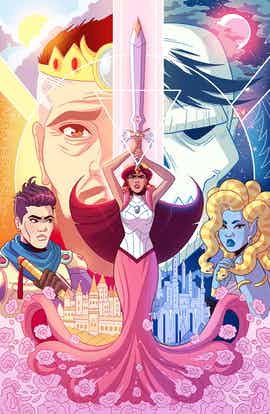
Andrew Wheeler and Paulina Ganucheau’s “Another Castle” # begins with a blast of fairy tale sweetness: a castle, a medieval-inspired font for its narration, birds singing outside in bucolic sunshine. Ganucheau’s linework and pastel candy colors deliberately scream “Disney Princess,” while her scrupulous attention to background details like Princess Misty’s jewelry makes the settings rich. Ganucheau’s successful visual mimicry gives the opening sequence and the resulting skewering of a bird more sharpness and sting. Unfortunately, the parody or satirical element ends with the first scene. The rest of “Another Castle” #1 contains standard fairy tale and fantasy elements like a spyglass, a wicked witch and a dragon, but Wheelers’ usage of genre tropes becomes less thoughtful.
The heroine, Princess Mistry, is a specimen belonging to the category of Reluctant or Rebellious Princesses, plentiful throughout 20th and 21st century literature, film and comics. There are several even within the Disney canon, notably Jasmine in “Aladdin” and Merida in “Brave.” Since it’s been done before, it’s easy to compare Princess Misty’s attitude and even the substance of her complaints to other stories that simultaneously embrace and subvert the fairy tale tradition.
Wheeler tries too hard to make Princess Misty a role model. She’s brave, but more headstrong than smart, and her character ends up feeling a little flat and forced. She comes across as spoiled and needlessly feisty rather than feminist when she whines about palace life. In Patricia Wrede’s “Enchanted Forest Chronicles” book series, Princess Cimorene is also frustrated with her limited independence and stultifying education, with near-identical complaints about “dresses and dances and carriage rides.” Just like Misty, she’s scheduled to be married off to a dopey prince who thinks too much of himself. Unlike Misty, Cimorene’s frustrations are far more sympathetic because she’s already exercised her brains and initiative in challenging her situation in cannier ways before taking the nuclear option.
Misty’s lack of care about consequences sets up a later plot point in the last scene of “Another Castle” #1, in which she suddenly develops a regard for servants and other royal subjects. Wheeler tells the reader what characters think and feel instead of showing it. His pacing is too rapid, and Misty’s self-sacrificing speech in the last scene is too cliched to hold any pathos. Similarly, Misty’s decision to hand over a sword to Pete the dumb prince doesn’t stand up to scrutiny. It’s an obvious plot contrivance. Finally, the plot progression from an arranged marriage to forced marriage is so by-the-book that there is zero suspense generated.
Wheeler is much more successful with the supporting cast, possibly because he’s not trying to prove a point with them and just has some fun. He uses a light hand in writing Fosmoth the Jailor and Gorga the attendant, and they end up being the best parts of “Another Castle” #1. I love Wilson’s whimsy and originality in creating a maidservant who is part-Gorgon and a prison guard who is into baking. Ganucheau’s facial expressions and body language eloquently convey Fosmoth and Gorga’s hurt and surprise when Misty rejects their friendly gestures. It’s a hilarious touch to have Gorga’s snake-hair hiss while sinking teeth into a scone, or to have Fosmoth persist in offering baked goods. “Another Castle” #1 is a kid-friendly comic, but it holds the most interest for adults in these scenes.
Ganucheau’s panel and page composition sometimes try too hard to be exciting, like when she tilts the panels for Misty’s escape attempt, but she nails the pacing and composition for the shock of Misty’s discovery of “another castle,” which proves to be more than just an allusion to “Legend of Zelda.” As visual symbolism for a dark past, the other castle works well and functions like a tamer version of discovering Bluebeard’s wives. It also seems beside the point, because it’s not as if the reader wasn’t clued into Badlus’ evil nature already many times over, starting with his very name. The ending to “Another Castle” #1 is a too-predictable vow of victory and revenge.
The exposition in “Another Castle” #1 is heavy-handed, and the feminist slant — while well-intentioned — doesn’t have strong enough characterization and action to back it up. However, Fosmoth and Gorga are endearing enough that I’d read more issues just to see what Wheeler does with them.

